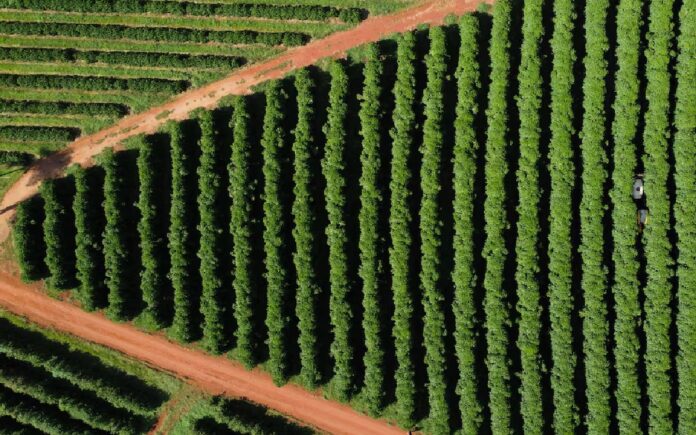Guaxupe, Brazil: Drought severely impacted Brazil’s coffee farmers last year, drying up plantations and driving global coffee prices to record highs. However, Rodrigo Brondani anticipates a strong harvest.
Brondani manages Joha Farm in Bahia’s vast savanna, a stark contrast to the mountainside coffee farms typically seen across Latin America. Inspecting rows of coffee plants, he watches an irrigation system pass overhead, ensuring consistent hydration.
“This is looking very good,” said Brondani, who oversees 900 hectares (2,224 acres) of irrigated coffee fields—more than 20 times the size of an average Brazilian coffee farm.
Large-scale, irrigated farms like Joha are increasingly essential in sustaining Brazil’s position as the world’s largest coffee producer. In Bahia’s western region, a new frontier for coffee cultivation, most farms now rely on irrigation.
Brondani expects his farm to yield up to 80 60-kg (132.3 pounds) bags of coffee per hectare, double Brazil’s national average. At current market prices, the farm’s most recent harvest, completed in October, is valued at around $17 million.
A Changing Industry
Interviews with over 20 farmers, officials, agronomists, and industry experts indicate that climate change is forcing Brazil’s coffee sector to shift away from traditional reliance on seasonal rains. Historically, only 30% of Brazil’s coffee farms utilized irrigation. That figure is now rising as unpredictable rainfall patterns disrupt production.
However, irrigation comes with steep costs. Water availability varies, and in Minas Gerais—the heart of Brazil’s traditional coffee-growing region—falling water tables have made irrigation increasingly difficult.
In contrast, Joha Farm benefits from a vast water supply, allowing irrigation for up to 20 hours per day. This has protected its crops, whereas other farms suffered from severe drought, with many trees unable to recover in time to support the 2025 harvest.
Even surviving coffee trees in Minas Gerais remain weakened, producing fewer beans. Analysts predict that Brazil’s coffee production—accounting for approximately 35% of global supply—will decline further.
“People say that without irrigation it will be very hard to produce coffee profitably,” said farmer Osmar Junior, who saw production at his Minas Gerais farm plummet from 2,000 bags in 2020 to just 700 bags in 2024 due to water shortages.
Supply Deficits and Rising Prices
Coffee consumption has exceeded production in four of the past six years. According to the International Coffee Organization, the world has consumed 12.5 million more bags than it has produced over the past three years, equivalent to roughly 7% of annual global supply.
As a result, coffee prices have surged. Arabica futures hit a record $4.40 per pound on February 13, after skyrocketing 70% in 2024. Major brands such as Nestlé’s Nespresso, Starbucks, and JDE Peet have already raised prices, with analysts predicting further increases for consumers.
Also Read | Ukraine’s Grain Exports Face Uncertainty Amid Pricing Dispute
The Cost of Irrigation
Brondani’s employer, AFB&IOB, one of Brazil’s largest coffee producers, views irrigation as the industry’s future.
“In our view, coffee farming has changed for good,” said Sergio Vieira, a director at AFB&IOB, which owns 20,000 hectares of coffee plantations.
Water access is now a key factor in expansion. Western Bahia sits atop the Urucuia aquifer, one of the world’s largest, with water just 20 meters below the surface in some areas. In contrast, Minas Gerais farmers must drill up to 300 meters deep, a costly and risky endeavor.
Several Minas Gerais municipalities imposed irrigation limits in 2024 due to drought conditions. “I have an irrigation system, but there was no water,” said Mario Alvarenga, who farms 300 hectares in Perdoes, Minas Gerais.
Sustainability and the Future
Fundação Procafé, a coffee research body, reports alarming soil moisture deficits in Minas Gerais. By October 2024, the region faced a deficit of 300 mm—compared to a long-term surplus of 20 mm—raising concerns about the sustainability of coffee farming.
Beyond water access, irrigation infrastructure requires significant investment. A central pivot irrigation system costs around 1.5 million reais ($263,000), while a drip irrigation system costs about 40,000 reais ($6,991) per hectare.
“It is a very high investment for a farmer,” said Hu



